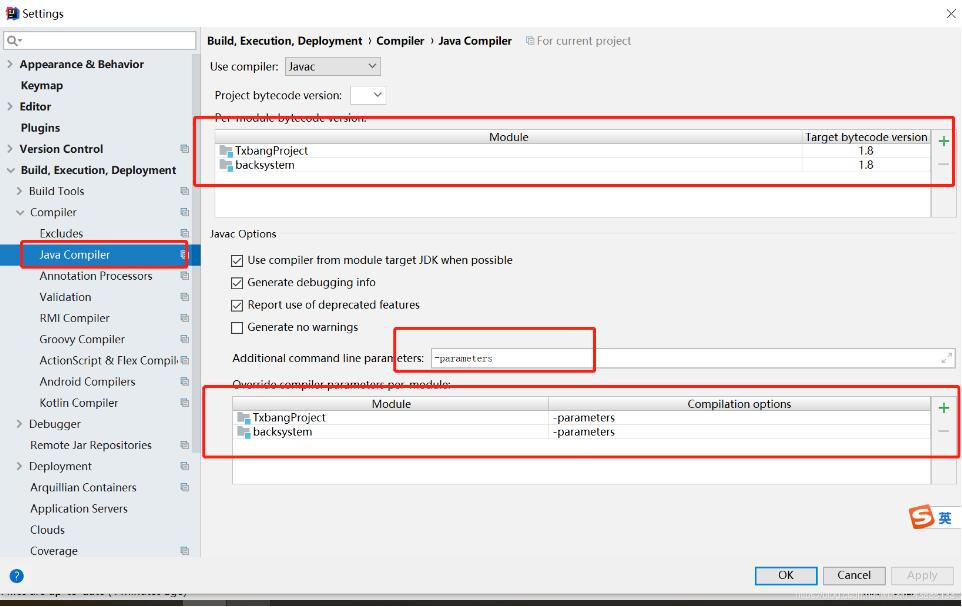mybatis不加@Parm注解報(bào)錯(cuò)的解決方案
我的idea版本2017.3.4,低版本貌似不會(huì)加上這個(gè)配置,idea高版本會(huì)

補(bǔ)充知識(shí):Mybatis傳多個(gè)參數(shù)的問(wèn)題 及MyBatis報(bào)錯(cuò) Parameter ’0’ not found. Available parameters are [arg1, arg0, param1 問(wèn)題
對(duì)于使用Mybatis ,傳多個(gè)參數(shù),我們可以使用對(duì)象封裝外,還可以直接傳遞參數(shù)
對(duì)象的封裝,例如查詢(xún)對(duì)象條件basequery對(duì)象
<select parameterType='com.niulande.product.query.BaseQuery' resultMap='BaseResultMap'> select <include refid='Base_Column_List' /> from pd_product <include refid='whereSql'/> </select> <sql > <where> <if test='gameCode != null and gameCode != ’’' > and game_type_coding = #{gameCode} </if> <if test='goodsTypeId != null'> and goods_type_id = #{goodsTypeId} </if> <if test='accId != null'> and account_id = #{accId} </if> <if test='delFlag != null'> and del_flag = #{delFlag} </if> </where> limit #{start},#{rows} </sql></mapper>
直接傳遞參數(shù)
例如:
mapper方法
selectByGameIdAndGoodsTypeId(Long gameTypeId, Long goodsTypeId);
對(duì)應(yīng)的xml文件方法:
<select resultMap='BaseResultMap'> select <include refid='Base_Column_List' /> from pd_game_goods_type_mid where game_type_id = #{gameTypeId} AND goods_type_id = #{goodsTypeId}</select>
第一:在select標(biāo)簽后就不再使用parameterType,因?yàn)檫@個(gè)標(biāo)簽只能指定一個(gè)參數(shù),而兩個(gè)參數(shù)及以上的,則不用再使用
第二:在sql語(yǔ)句里面以上的寫(xiě)法是錯(cuò)誤的(為了演示執(zhí)行報(bào)錯(cuò))
會(huì)報(bào)錯(cuò)
Parameter ’0’ not found. Available parameters are [arg1, arg0, param1, param2]
注意這里使用的mybatis的版本號(hào)
在MyBatis3.4.4版不能直接使用#{0}要使用 #{arg0}
0是指參數(shù)的索引,從0開(kāi)始。第一個(gè)參數(shù)是0,第二個(gè)參數(shù)是1,依次類(lèi)推
以下正確的寫(xiě)法:
<select resultMap='BaseResultMap'> select <include refid='Base_Column_List' /> from pd_game_goods_type_mid where game_type_id = #{arg0} AND goods_type_id = #{arg1}</select>
第三種:
<select resultMap='BaseResultMap'> select <include refid='Base_Column_List' /> from pd_game_goods_type_mid where game_type_id = #{gameTypeId} AND goods_type_id = #{goodsTypeId}</select>
剛剛說(shuō)這樣的會(huì)報(bào)錯(cuò)。解決辦法,更改mapper方法
加上@Param注解
selectByGameIdAndGoodsTypeId(@Param('gameTypeId')Long gameTypeId, @Param('goodsTypeId') Long goodsTypeId)
以上這篇mybatis不加@Parm注解報(bào)錯(cuò)的解決方案就是小編分享給大家的全部?jī)?nèi)容了,希望能給大家一個(gè)參考,也希望大家多多支持好吧啦網(wǎng)。
相關(guān)文章:
1. Mysql入門(mén)系列:MYSQL圖像數(shù)據(jù)的處理2. Mysql InnoDB的鎖定機(jī)制實(shí)例詳解3. 淺談Mysql連接數(shù)據(jù)庫(kù)時(shí)host和user的匹配規(guī)則4. MySQL Community Server 5.1.495. MySQL中InnoDB和MyISAM類(lèi)型的差別6. 全面解讀MySQL主從復(fù)制,從原理到安裝配置7. MySQL分區(qū)的優(yōu)點(diǎn)8. SQLite3的綁定函數(shù)族使用與其注意事項(xiàng)詳解9. MYSQL(電話號(hào)碼,身份證)數(shù)據(jù)脫敏的實(shí)現(xiàn)10. Oracles XMLDB Study NOTE (2)

 網(wǎng)公網(wǎng)安備
網(wǎng)公網(wǎng)安備